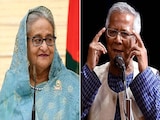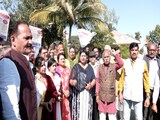The allure of South Korean 'glass skin' trend is gaining popularity all across the Indian subcontinent. The radiant, poreless, and translucent complexion achieved from a particular K-beauty ritual is a new beauty obsession in India. While the beauty philosophy of skin hydration is sound, for many Indians, this pursuit results in harmful effects that may be lifelong. These side effects range from hyperpigmentation of the skin, which is particularly prevalent in Indian skin types, to burns and allergies on sensitive skin types. From oily to dry skin, the melanin in Indian skin varies, which makes for a unique genetic makeup as well as specific care to achieve hydrated skin. And so, not every global beauty trend is suitable for Indian skin types.
The damaging and potentially unrealistic beauty standards set often by K-beauty trends don't just affect the physical appearance of consumers in countries like India, but also impact the mental health. In the age of heavy social media usage, teenagers and young girls are becoming susceptible to following curated online personas. This leads to the development of body dysmorphia (a mental health condition where, due to digitization of the female body, people become obsessed with flaws in their appearance, and this impairs daily functioning).
The statistics are alarming, as a study from the International Journal of Indian Psychology (2024) indicates by analysing the data from teenage girls from Delhi-NCR. In this study, teenage girls aged 13-16 from a North-West Delhi school had a negative body image of themselves. This is a result of constant exposure to international beauty standards, which enforce unrealistic beauty ideals on the impressionable minds of developing brains online.
What Does The Science Of Skincare Say About Korean Glass Skin?
The fundamental obstacle to achieving the exact South Korean 'glass skin' look lies in genetics and the environment. The main argument is that the South Korean 'glass skin' standard, which has become an epitome of cultural beauty, is influencing Indian beauty ideals, yet genetic and environmental differences make this pursuit impractical and potentially harmful for most Indians.
The Indian skin tones range from light brown to dark brown (thicker skin, high melanin content, and Indian skin tends to tan rather than burn when exposed to the sun for long hours). Melanin is a natural pigment that gives colour to the skin, and its density in the skin decides which skin tone the person possesses.
The exact skin-tones of Indians vary depending on their geographical location as climate and genetics both determine the external appearance of the skin. While South Korean glass skin products are designed primarily for the South Korean skin, this defeats the purpose of using glass skin products to achieve a translucent finish on Indian skin.
In a research thesis, it is stated that the appeal of South Korean skincare products is also linked to a perception of their uniqueness and the supposed use of natural ingredients. But the main question lies, does the term 'natural' really mean it doesn't have any standard chemical bases that are found in almost all beauty products in the market? It doesn't, and that is precisely why being cautious while buying K-beauty products is necessary.
What Types Of Korean Beauty Products May Be Harmful For Indian Skin?
The obsession with fairness in the Indian market and its connection to the South Korean beauty glass skin craze necessitates caution. Be careful while purchasing products that may leave lasting side effects on your skin. Check the label and do your own research.
Here are types of beauty products that won't work on Indian skin, as their composition is according to the climate, weather, and seasons in South Korea:
- Heavy balms and creams
- Ultra-rich sleeping masks
- Heavy emulsifying cleansing balms
Photo Credit: Freepik
What Korean Beauty Products Can Be Beneficial For Indian Skin?
When it comes to the diverse Indian skin tone, adapt the routine, don't adopt it as is, as your skin needs are very different from the effect of certain products:
- Lightweight textures: gels, water-creams, essence, or lotion.
- Calming ingredients (Centella Asiatica ( cica for short), green tea, mugwort for redness, irritation).
- Brightening, not bleaching, with ingredients like niacinamide, rice water, and Vitamin C for hyperpigmentation, a common Indian skin concern.
- Simple routine: Cleanse, treat, moisturize, SPF with the right products.
Please note: Some people may be allergic to green tea in beauty products. Please do a patch test to be safe before using a new product with green tea and consult a dermatologist, especially if you have sensitive skin and pre-existing skin conditions.
What Are The Potential Side-effects Of Using Korean Glass Skin Products?
There are types of broadside effects that can occur on Indian skin when South Korean 'glass skin' products are used by Indians. Here they are:
- Hyperpigmentation: As Indian skin tones have a higher concentration of melanin, their skin is prone to hyperpigmentation. The translucent or porcelain-like appearance can't be achieved in Indian skin-tones, as the genetic makeup of our skin is different.
- Climate and Sebum: The hot climate in India, higher sebum production. South Korean 'glass skin' products won't work as a poreless finish is impossible.
- Healthy Glow vs Glass Skin: The mindset that demands unrealistic glass skin needs to be shifted to achieve a healthy, even-toned glow.
- Mental Health Toll: Manifestation of body dysmorphia disorder, body image dissatisfaction disorders.
- Perfection Pressure: Anxiety to achieve perfection.
- Colourism reinforcement: The prevalence of societal colourism is made acceptable.
The South Korean glass skin phenomenon is propelled by cultural beauty ideals rather than scientific backing for Indian consumers. The main argument is that caution is needed, as Indian skin requires science-based, individualized care instead of trends shaped by other cultures. Healthy skepticism and evidence-based routines are necessary when evaluating such global beauty trends.
According to Dr DM Mahajan, Senior Consultant, Dermatology, Indraprastha Apollo Hospitals has said, "Korean glass skin products have been super popular for offering the promise of radiant, dewy-looking skin. They usually bring together several steps, cleansing, exfoliating, toning, serums, essences, and moisturizers aimed at hydrating and smoothing out the skin.
Many find improvements in the texture and brightness of their skin, but let's be real here, not everybody will react well to this. Some people can develop side effects like redness, irritation, breakouts, or heightened sensitivity, especially if the products have harsh acids, fragrances, or alcohol. Piling on several products with active ingredients can also interfere with the skin's natural barrier and cause dryness or inflammation. Also, individuals with acne or sensitive skin can see clogged pores or flare-ups when they use heavy moisturizers or occlusive masks.
Patch testing new products and introducing them slowly is important to reduce the risk of bad reactions. Also, note that achieving a 'glass skin' effect usually depends on temporary hydration and surface glow, and not on structural changes in the skin. Thus, adding these routines to a dermatologist-endorsed skincare routine, including sun protection and gentle hydration, is the safest option. Members are advised to stop using any product that leads to ongoing irritation and consult a professional if reactions intensify, with the quest for radiant skin not coming at the expense of general skin health."
Disclaimer: This content, including advice, provides generic information only. It is in no way a substitute for a qualified medical opinion. Always consult a specialist or your own doctor for more information. NDTV does not claim responsibility for this information.
References:
Gupta, M., Jassi, A., & Krebs, G. (2023). The association between social media use and body dysmorphic symptoms in young people. Frontiers in Psychology.
Khosla, Shreya. (2024). Exploring the Influence of Social Media on Body Image: A Study on Adolescent Girls. International Journal of Indian Psychology. 12. 1112-1124.
NUNEZ, J. (2023). ... COVID-19 WITH SPECIAL REFFERENCE TO K-DRAMA AND ELECTRONIC PRODUCTS AND FREQUENCY OF PURCHASES OF KOREAN PRODUCTS.















